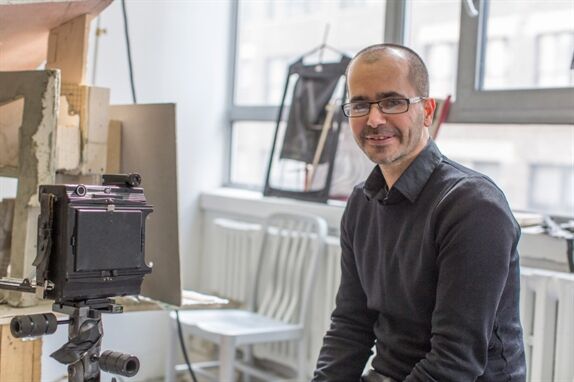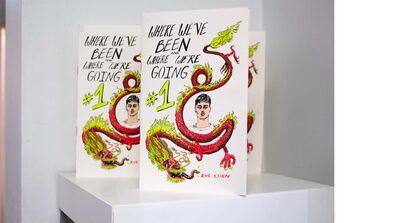
Looking Behind to Move Forward
by Jeremy Ohmes
There is rubble everywhere. On one side, a white piano has collapsed in the middle of a bombed-out building. Chunks of plaster and stone are spread across the floor while a pockmarked staircase ascends in the background. On the other side, a swimming pool is emptied of water, and filled with debris. Two columns precariously hold up what might have been a palace overlooking a desert in Iraq. Wafaa Bilal (MFA 2003) leans over these scenes and scatters human ashes across the detritus.
Bilal is in his studio, a cramped space at the Elizabeth Foundation for the Arts in New York. The artist squeezes between the small, tabletop models he has built that depict these ruined landscapes. He notes that there are exactly 21 grams of ashes in each work—“a very symbolic gesture to insert the aura of the human into the work.” Then he snaps a photo. The miniature reconstructions become real, conveying an overwhelming sense of loss and destruction, the remains of a place ripped apart by war.
Bilal began The Ashes Series in 2003 at the start of the Iraq War. As an Iraqi refugee who fled to the United States in 1992, the SAIC alum watched the destruction of his country from afar. Besieged by violent images via the internet and cable news, he felt helpless in his exile abroad and he longed to go home.

In Iraq, Bilal was an aspiring painter who dreamed of studying art. He was prohibited, however, because of his family’s political stand against Saddam Hussein. He says, “art was viewed by the regime as a very strong way to influence people, especially youth.” Instead he studied geography. During his five years at the University of Baghdad, the undaunted artist continued to make work that was critical of his country’s dictatorship. Soon he was arrested as a dissident. In 1990, when Iraq invaded Kuwait, Bilal organized anti-war opposition groups. He lived under the constant threat of arrest and execution, and eventually was forced to flee. He spent two years at a refugee camp in Saudi Arabia, then emigrated to the United States.
In America, Bilal branched out into printmaking, photography, and installation. But when he began his graduate program at SAIC in the Art and Technology Studies department in 2001, he started exploring ideas of physical installation, performance, and interactivity. “I had a deep desire to engage the audience,” he notes. “Not only on the physical level, but how an artist can affect the viewer to become emotionally involved.”
By the time Bilal graduated from SAIC, his new country was occupying his home country. A year later, he received news that his brother, Haji, had been killed by an unmanned Predator drone. Soon after, his father died of grief. “For three years I thought about how to engage with that,” says Bilal. Then he saw an interview with an American soldier who operated the drones and was directed to drop missiles on Iraqi targets. “I was surprised there was no emotional connection to the people on the ground. And it struck me how we can become disconnected from reality when we live in a comfort zone.”
His response was a performative installation piece titled Domestic Tension. Bilal confined himself to a room in Chicago’s Flatfile Galleries for 31 days, accepting only donated food. In the room with him was a robotic paintball gun connected to the project’s website and operated remotely by online viewers. People from all over the world could shoot Bilal with yellow pellets any time they wanted and as many times as they wanted—and that is exactly what they did. By the end of the month, the project’s website had 80 million hits and Bilal was shot by 70,000 paintballs.
Most of his days were spent dodging the salvo of paint-splattering, welt-inducing projectiles. Occasionally, he would take cover behind a plastic screen to interact with shooters and follow their chat room discussions. He encountered video gamers talking shop with hunters, anti-war participants debating with pro-war participants, people posting encouraging words, and people attacking him with racist comments. At one point a group of programmers hacked the software to make the gun rapid-fire on full automatic; however, another group of hackers stepped in to deny the shooters, aiming the gun to the side to protect the artist.
Domestic Tension received substantial press. The Chicago Tribune called it “one of the sharpest works of political art to be seen in a long time” and named him 2008 Artist of the Year. But more importantly, the piece initiated a debate around a conflict that was largely invisible to the American public. Bilal says, “People didn’t see this as only an art project, but as a way to engage a public who were disappointed there wasn’t a larger, mainstream conversation about the war in Iraq.”
For another interactive project, and Counting..., Bilal turned his body into a canvas. During a 24-hour live performance, he tattooed his back with a dot for each Iraqi and American casualty of the war. The 5,000 American soldiers were represented by visible red dots, while the 100,000 Iraqi casualties were represented by UV green dots, invisible unless viewed under a black light. During the performance visitors read the names of the dead and donated a dollar to fund scholarships for Americans and Iraqis who lost parents in the war.
Perhaps Bilal’s most renowned work is 3rd i. In 2010–11, he surgically embedded a camera in the back of his head. Connected to the Internet, the camera captured hi-res images and posted them to the project’s website.
He says, “Being an Arab-American and an Iraqi refugee, I understand that I’m being watched all of the time. In fact, I had read that there are two people watching every Middle Eastern suspect at all times. I wanted to say here is every minute of my life; it is really boring.”
One image was uploaded every minute for an entire year, and the 3rd i website amassed 500,000 images. Simultaneously mundane, abstract, and critical of a surveillance state, the pictures are also a commentary on the places that Bilal has left behind. On the website (3rdi.me), the artist says: “During my journey from Iraq to...the U.S., I left many people and places behind. The images I have of this journey are inevitably ephemeral, held as they are in my own memory. Many times while I was in transit and chaos the images failed to fully register, I did not have the time to absorb them. Now, in hindsight, I wish I could have recorded these images so that I could look back on them, to have them serve as a reminder and record of all the places I was forced to leave behind and may never see again.”
Back in his studio, Bilal quietly motions to the ashen, monochromatic ruins of the places from his past. Compared to his interactive work, which requires so much physical and mental effort and endurance, building the models for The Ashes Series is a meditative act—one that not only brings Bilal closer to home, but allows him to acknowledge the losses and effects of war. “When we go through these atrocities, we want to deny that they ever existed,” he says softly. “But these small gestures of building and photographing allow me to acknowledge the losses and connect to my home.” And they allow his audiences to engage with different perspectives and uncomfortable issues.
